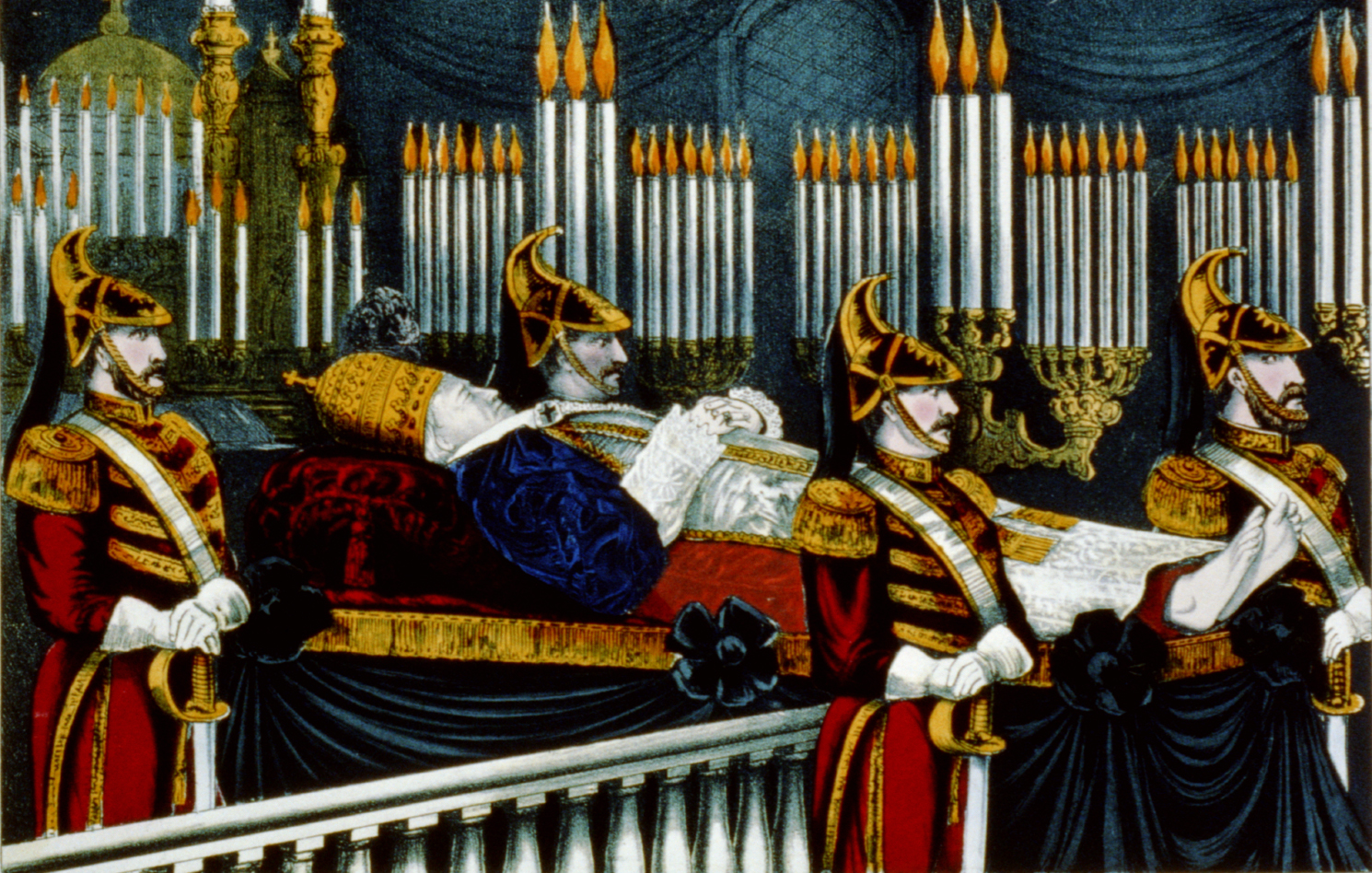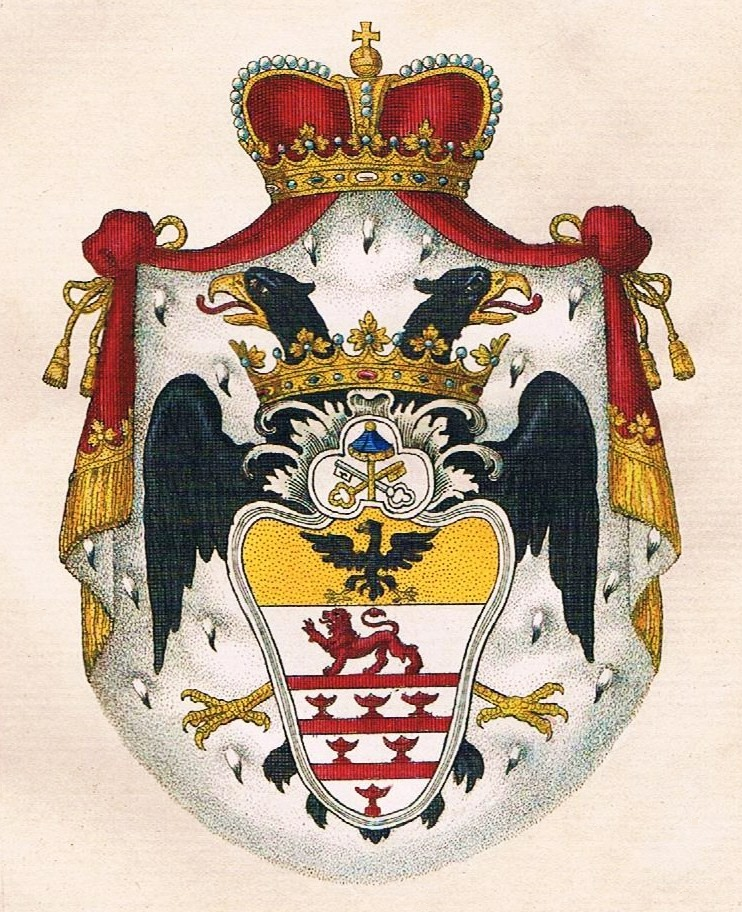|
Black Nobility
The black nobility or black aristocracy ( it, nobiltà nera, aristocrazia nera) are Roman aristocratic families who sided with the Papacy under Pope Pius IX after the Savoy family-led army of the Kingdom of Italy entered Rome on 20 September 1870, overthrew the Pope and the Papal States, and took over the Quirinal Palace, and any nobles subsequently ennobled by the Pope prior to the 1929 Lateran Treaty. For the next 59 years, the Pope confined himself to Vatican City and claimed to be a prisoner in the Vatican to avoid the appearance of accepting the authority of the new Italian government and state. Aristocrats who had been ennobled by the Pope and were formerly subjects of the Papal states, including the senior members of the Papal Court, kept the front doors of their palaces in Rome closed to mourn the Pope's confinement, which led to their being called the "black nobility". History Despite the relatively recent name, the Black Nobility had existed for centuries, originati ... [...More Info...] [...Related Items...] OR: [Wikipedia] [Google] [Baidu] |
Colonna Family
The House of Colonna, also known as ''Sciarrillo'' or ''Sciarra'', is an Italian noble family, forming part of the papal nobility. It was powerful in medieval and Renaissance Rome, supplying one pope ( Martin V) and many other church and political leaders. The family is notable for its bitter feud with the Orsini family over influence in Rome, until it was stopped by papal bull in 1511. In 1571, the heads of both families married nieces of Pope Sixtus V. Thereafter, historians recorded that "no peace had been concluded between the princes of Christendom, in which they had not been included by name". History Origins According to tradition, the Colonna family is a branch of the Counts of Tusculum — by Peter (1099–1151) son of Gregory III, called Peter "de Columna" from his property the Columna Castle in Colonna, in the Alban Hills. Further back, they trace their lineage past the Counts of Tusculum via Lombard and Italo-Roman nobles, merchants, and clergy through the Early ... [...More Info...] [...Related Items...] OR: [Wikipedia] [Google] [Baidu] |
Ruspoli
The House of Ruspoli is historically one of the great aristocratic families of Rome, but is originally from Florence. Following World War II and the fall of Fascism, the newly established Italian Republic officially abolished titles and hereditary honours in its 1946 Constitution, with the exception of the papal nobility of Rome (fourteen families, among which is the Ruspoli family), as those titles had been created by papal authority. History The origins of the family can be traced back to the Ruspoli of Florence in the 13th century, and more remotely from Marius Scotus in the 8th century and his descendants the Marescotti of Bologna. In the 16th century, the Ruspoli family moved to Rome, where the last descendant, Vittoria Ruspoli, Marchioness of Cerveteri, married Sforza Vicino Marescotti, Count of Vignanello, a descendant of the Farnese family on both his mother's and father's side. One of Vittoria's sons took the Ruspoli name and coat of arms to guarantee the continuity of ... [...More Info...] [...Related Items...] OR: [Wikipedia] [Google] [Baidu] |
Synod
A synod () is a council of a Christian denomination, usually convened to decide an issue of doctrine, administration or application. The word '' synod'' comes from the meaning "assembly" or "meeting" and is analogous with the Latin word meaning "council". Originally, synods were meetings of bishops, and the word is still used in that sense in Catholicism, Oriental Orthodoxy and Eastern Orthodoxy. In modern usage, the word often refers to the governing body of a particular church, whether its members are meeting or not. It is also sometimes used to refer to a church that is governed by a synod. Sometimes the phrase "general synod" or "general council" refers to an ecumenical council. The word ''synod'' also refers to the standing council of high-ranking bishops governing some of the autocephalous Eastern Orthodox churches. Similarly, the day-to-day governance of patriarchal and major archiepiscopal Eastern Catholic Churches is entrusted to a permanent synod. Usages i ... [...More Info...] [...Related Items...] OR: [Wikipedia] [Google] [Baidu] |
Roman Catholic Diocese Of Asti
The Diocese of Asti ( la, Dioecesis Astensis) is a Roman Catholic ecclesiastical territory in Piedmont, northern Italy, centered in the city of Asti. It has been a suffragan of the Archdiocese of Turin since 1515."Diocese of Asti" ''''. David M. Cheney. Retrieved February 29, 2016."Diocese of Asti" ''GCatholic.org''. Gabriel Chow. Retrieved February 29, 2016. Previous to that, it was a suffragan of the Archdiocese of Milan. The diocese lost territory in 1175, when the diocese of Alessandria was created. I ... [...More Info...] [...Related Items...] OR: [Wikipedia] [Google] [Baidu] |
House Of Rosetti
The House of Rosetti (also spelled ''Ruset'', ''Rosset, Rossetti'') was a Moldavian boyar princely family of Byzantine Greek and Italian (from Genoa) origins. There are several branches of the family named after their estates: Roznovanu, Solescu, Bălănescu, Răducanu, Ciortescu, Tescanu, and Bibica. The Rosetti family in Wallachia is another branch of the family who initially settled in Moldavia. Notable members * Alexandru Rosetti, linguist *Elena Cuza, philanthropist; the Princess consort of the United Principalities and the wife of Prince Alexandru Ioan Cuza * C. A. Rosetti, Prime Minister, statesman, and writer * Maria Rosetti, political activist, journalist, philanthropist and socialite *Maria Tescanu Rosetti, lady-in-waiting *Radu D. Rosetti, poet *Radu R. Rosetti, general and historian *Theodor Rosetti Theodor Rosetti (5 May 1837, Iași or Solești, Moldavia – 17 July 1923, Bucharest, Romania) was a Romanian writer, journalist and politician who served as Prime ... [...More Info...] [...Related Items...] OR: [Wikipedia] [Google] [Baidu] |
Conti Di Segni
The counts of Segni ( it, Conti di Segni, la, de Comitibus Signie, also known as ''Conti'' or ''De Comitibus'' for short) were an important noble family of medieval and early modern Italy originating in Segni, Lazio. Many members of the family acted as military commanders or ecclesiastical dignitaries, including many cardinals and four popes. The family is on historical record beginning with Trasimondo, the father of Lotario Conti, who became Pope Innocent III in 1198. The second Conti pope was Ugolino (1227-1241), as Gregory IX, the third Rinaldo, as Alexander IV (r. 1254-1261). Bishop Paul of Tripoli (1261–1285) was a Conti and his sister Lucienne was the princess of Antioch. Medieval to Renaissance era cardinals of the family include Giovanni dei Conti di Segni, Niccolò dei Conti di Segni, Ottaviano di Paoli, Giovanni Conti (d. 1493) and Francesco Conti (d. 1521). In medieval Rome, both the Torre dei Conti (built in 1238) and the Torre delle Milizie, testified to th ... [...More Info...] [...Related Items...] OR: [Wikipedia] [Google] [Baidu] |
Aldobrandini Family
The House of Aldobrandini is an Italian noble family originally from Florence, where in the Middle Ages they held the most important municipal offices. Now the Aldobrandini are resident in Rome, with close ties to the Vatican. History Their Roman fortunes were made when Ippolito Aldobrandini became pope under the name Pope Clement VIII. He arranged the marriage that linked the Aldobrandini with the Roman family of Pamphili. They were also linked to marriage alliances with the Farnese (Ranuccio I, duke of Parma, had married Margherita Aldobrandini) and Borghese (since Olimpia Aldobrandini married Paolo Borghese). The family also lends its name to the Palazzo Aldobrandini on the Quirinal Hill. The Aldobrandini family, having reached the height of its powers when Ippolito Aldobrandini became Pope Clement VIII (1592–1605), began the building of the villa. In 1600 Clement VIII acquired the Orti Vitelli on the Quirinal hill and in 1601 donated the property to his Cardinal-nephe ... [...More Info...] [...Related Items...] OR: [Wikipedia] [Google] [Baidu] |
Caetani
The House of Caetani, or Gaetani, is the name of an Italian noble family, originally from the city of Gaeta, connected by some to the lineage of the lords of the Duchy of Gaeta, as well as to the patrician Gaetani of the Republic of Pisa. It played an important role in Rome, in the Papal States and in the Kingdom of Naples, and later in the Kingdom of the Two Sicilies. Origins The Caetani, or Gaetani family, according to a family tradition, was descendant of the Dukes of Gaeta. Nevertheless, the family had no more great importance in Rome until the election of Benedetto Caetani to the papacy as Pope Boniface VIII in 1294, when they at once became the most notable in the city. The pope helped them to buy Sermoneta, Bassiano, Ninfa and San Donato (1297, 1300), and the marquisate of Ancona in 1300, while Charles II of Anjou created the pope's brother count of Caserta. Giordano Roffredo Caetani by his marriage with Giovanna dell'Aquila, heiress of the counts of Fondi, in 1297 acq ... [...More Info...] [...Related Items...] OR: [Wikipedia] [Google] [Baidu] |
Savelli Family
The House of Savelli (de Sabellis in documents) were a rich and influential Roman aristocratic family who rose to prominence in the 13th century, the youngest is still alive today (1626–2022). History The family, who held the lordship of Palombara Sabina, took their name from the '' rocca'' (castle) of Sabellum, near Albano, which had belonged to the counts of Tusculum before it passed to the Savelli. Early modern genealogies of the Savelli, such as the unpublished manuscript "eulogistic treatise" compiled by Onofrio Panvinio, drew connections to Pope Benedict II, a possible but undocumentable connection, and even to the cognomen Sabellius of Antiquity. They provided at least two popes: Cencio Savelli, Pope Honorius III (1216–1227) and Giacomo Savelli, Honorius IV (1285–1287). His father, Luca Savelli, was a Roman senator and sacked the Lateran in 1234. Luca's decision to side with Emperor Frederick II against Honorius III's successor, Gregory, brought various material ... [...More Info...] [...Related Items...] OR: [Wikipedia] [Google] [Baidu] |
Erba-Odescalchi
The House of Erba-Odescalchi () and the House of Odescalchi are branches of an Italian noble family formed by the union of the Erba and Odescalchi families. The Odescalchi family was, since the election of Benedetto Odescalchi as Pope Innocent XI in 1676, part of the highest Roman aristocracy. Odescalchi family The Odescalchi family were entrepreneurs from the minor nobility of Como. They trace their family line to Giorgio Odescalchi of Como, born around 1290. Pietro Giorgio Odescalchi was Bishop of Alessandria (1598–1610) and then Bishop of Vigevano (1610–1620). In 1619, Benedetto's brother and three uncles founded a bank in Genoa, which grew into a successful money-lending business. After completing his studies in grammar and letters, the 15-year-old Benedetto moved to Genoa to take part in the family business as an apprentice. The family established lucrative financial transactions with clients in major Italian and European cities, such as Nuremberg, Milan, Kraków ... [...More Info...] [...Related Items...] OR: [Wikipedia] [Google] [Baidu] |
Borghese
The House of Borghese is a princely family of Italian noble and papal background, originating as the Borghese or Borghesi in Siena, where they came to prominence in the 13th century and held offices under the ''commune''. During the 16th century, the head of the family, Marcantonio, moved to Rome, where they rose in power and wealth following the election of his son Camillo as Pope Paul V in 1605. They were one of the leading families of the Black Nobility and maintain close ties to the Vatican. Borghese (Borghesi) of Siena The family originated with Tiezzo da Monticiano, a 13th-century wool merchant in Siena, whose nephew Borghese gave his name to the family. Among the important Sienese Borghese are: * Agostino (1390–1462), noted soldier in the wars between Siena and Florence, named count palatine by Pope Pius II and count of the Holy Roman Empire by Sigismund * Niccolò (1432–1500), man of letters, philosopher, and important political figure in the Sienese republic, belon ... [...More Info...] [...Related Items...] OR: [Wikipedia] [Google] [Baidu] |




